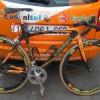Posted 16 February 2008 - 01:46 AM
Lots of leads in Pubmed for Aronia - here are a few:
Effect of anthocyanins from Aronia melanocarpa on blood pressure, concentration of endothelin-1 and lipids in patients with metabolic syndrome][Article in Polish]
Broncel M, Koziróg-Kołacińska M, Andryskowski G, Duchnowicz P, Koter-Michalak M, Owczarczyk A, Chojnowska-Jezierska J.
Uniwersytet Medyczny w Łodzi, Klinika Chorób Wewnetrznych z Oddziałem Farmakologii Klinicznej i Terapii Monitorowanej. ttm@ttm.org.pl
THE AIM OF THE STUDY: To estimate the influence of anthocyanins from Aronia melanocarpa on blood pressure, concentration of endothelin-1 (ET-1), serum lipids, fasting glucose, uric acid and membrane cholesterol in erythrocytes of patients (pts) with metabolic syndrome (MS). MATERIAL AND METHODS: The study comprised 22 healthy volunteers and 25 pts with MS treated with anthocyanins (3 x 100 mg/d) for 2 months. Waist circumference (> or = 80 cm for women and > or =94 cm for men), triglicerydes (TG) level >150 mg/dl (1.7 mmol/l), cholesterol-HDL (HDL-C) level < 40 mg/dl (1.0 mmol/l) for men and <50 mg/dl (1.3 mmol/l) for women, systolic blood pressure (SBP) >130 mmHg and/or diastolic blood pressure (DBP) >85 mmHg were inclusion criteria for patients with MS. Before and after 2 months of treatment the following parameters were determined: SBP, DBP, serum lipids (total cholesterol--TC, cholesterol LDL--LDL-C, cholesterol HDL--HDL-C, TG--by enzymatic method), membrane cholesterol in erythrocytes (method of IIcy), ET-1 (immunoenzymatic method), fasting glucose level was (colorimetric method), uric acid (enzymatic--colorimetric method). RESULTS: After two months therapy of anthocyanins from Aronia melanocarpa in comparison with baseline it was observed a significant decrease of: SBP (144.20 +/- 9.97 vs. 131.83 +/- 12.24 mmHg, p < 0.001) and DBP (87.20 +/- 9.9 vs. 82.13 +/- 10.33 mmHg, p < 0.05), TC (242.80 +/- 34.48 vs. 227.96 +/- 33.07 mg/dl, p < 0.001), LDL-C (158.71 +/- 35.78 vs. 146.21 +/- 34.63 mg/dl, p < 0.01), TG (215.92 +/- 63.61 vs. 187.58 +/- 90 mg/dl, p < 0.05), ET-1 (2.44 +/- 0.51 vs. 1.74 +/- 0.42 pg/ml, p < 0.001) and membrane cholesterol (4.85 +/- 0.65 vs. 2.81 +/- 0.54 mmol/Lpc, p < 0.001), uric acid and fasting blood glucose levels did not change significantly after study cessation. CONCLUSIONS: The results of our study show that anthocyanins from Aronia melanocarpa may be of benefit to patients with MS as for as atherosclerosis prevention is concerned. It seems to result from anthocyanins influence on blood pressure, serum lipid and endothelin-1 level.
Hypoglycemic and hypolipidemic effects of Aronia melanocarpa fruit juice in streptozotocin-induced diabetic rats.Valcheva-Kuzmanova S, Kuzmanov K, Tancheva S, Belcheva A.
Department of Preclinical and Clinical Pharmacology and Biochemistry, Medical University, Varna, Bulgaria. stefkavk@yahoo.com
Aronia melanocarpa fruit juice (AMFJ) is rich in phenolic antioxidants, especially flavonoids from the anthocyanin subclass. The aim of the present study was to investigate the influence of AMFJ on plasma glucose and lipids in diabetic rats. Diabetes was induced by an intraperitoneal injection of streptozotocin (50 mg/kg). AMFJ was applied by gavage at doses of 10 and 20 ml/kg for 6 weeks to normal and diabetic rats. Streptozotocin caused a significant elevation of plasma glucose by 141% and of plasma triglycerides (TG) by 64% in comparison with normal control rats and induced statistically insignificant elevations of total cholesterol and LDL-cholesterol and a reduction of HDL-cholesterol. Applied to normal rats, AMFJ did not influence plasma glucose and lipid levels. Applied to diabetic rats, AMFJ (10 and 20 ml/kg) significantly reduced plasma glucose by 44% and 42% and TG by 35% and 39%, respectively, to levels that did not significantly differ from those of the normal control rats and counteracted the influence of streptozotocin on total cholesterol, LDL-cholesterol and HDL-cholesterol. In conclusion, AMFJ significantly decreased the streptozotocin-induced abnormalities in blood glucose and TG in diabetic rats and might be useful in prevention and control of diabetes mellitus and diabetes-associated complications. Copyright 2007 Prous Science.
PMID: 17440626 [PubMed - indexed for MEDLINE]
Protective effect of Aronia melanocarpa fruit juice pretreatment in a model of carbon tetrachloride-induced hepatotoxicity in rats.Valcheva-Kuzmanova SV, Popova PB, Galunska BT, Belcheva A.
Department of Preclinical and Clinical Pharmacology and Biochemistry, Medical University, Varna, Bulgaria.
The main active ingredients of Aronia melanocarpa fruit juice (AMFJ) are phenolic substances, mainly flavonoids from the anthocyanin subclass. AIM: The aim of the present study was to investigate the effect of AMFJ applied as pretreatment in a model of carbon tetrachloride (CCl4)-induced hepatotoxicity in rats. MATERIAL AND METHODS: AMFJ was given orally to rats for 2 days at doses of 5, 10 and 20 ml/kg either alone or as pretreatment before the oral application of CCl4 (0.2 ml/kg, 2 days). The plasma activities of aspartate transaminase (AST) and alanine transaminase (ALT) were measured as markers of the liver cell damage. The levels of malondialdehyde (MDA), a lipid peroxidation marker, were determined in rat liver and plasma. RESULTS: Administration of CCl4 caused an elevation of plasma AST and ALT activities. It also induced an elevation of MDA levels in rat liver and plasma. AMFJ applied alone in the tested doses did not cause any significant changes in the measured enzyme activities and in MDA levels. AMFJ applied as pretreatment prevented the CCl4-induced increase of AST and ALT activities, and also prevented the elevation of plasma and liver MDA levels. CONCLUSIONS: AMFJ showed a protective effect in a model of CCl4-induced hepatotoxicity in rats. This effect might be due to the antioxidant activity of its active ingredients.
PMID: 17408078 [PubMed - indexed for MEDLINE]
Current knowledge of Aronia melanocarpa as a medicinal plant.Valcheva-Kuzmanova SV, Belcheva A.
Department of Preclinical and Clinical Pharmacology and Biochemistry, Medical University, Varna, Bulgaria.
Aronia melanocarpa, native to eastern North America, has become popular in Eastern Europe and Russia. Aronia melanocarpa fruits are one of the richest plant sources of phenolic substances, mainly anthocyanins--glycosides of cyanidin. Anthocyanins are water soluble pigments accounting for the dark blue and even black color of the fruits. Administered orally they can be absorbed as intact glycosides. Aronia melanocarpa fruit juice and anthocyanins derived from the fruits have been studied intensively for the last 15 years. Most of the effects of Aronia melanocarpa anthocyanins are due to their high antioxidative activity. Our investigations have demonstrated a remarkable hepatoprotective, a very good gastroprotective and a pronounced anti-inflammatory effect of Aronia melanocarpa fruit juice in rats as well as a bacteriostatic activity in vitro against Staphylococcus aureus and Escherichia coli and an antiviral activity against type A influenza virus. Research of other authors has demonstrated that Aronia melanocarpa anthocyanins can normalize the carbohydrate metabolism in diabetic patients and in streptozotocin-diabetic rats, have an in vitro antimutagenic activity and exhibit a distinct immunomodulatory activity in human lymphocyte cultures and in patients with breast cancer, suppress the growth of human HT-29 colon cancer cells, inhibit the N-nitrosamine formation in rats and decrease the toxicity and cumulation of cadmium in liver and kidneys. Currently, there are no data in literature about any unwanted and toxic effects of Aronia melanocarpa fruits, juice and extracts.
PMID: 17408071 [PubMed - indexed for MEDLINE]
Combination therapy of statin with flavonoids rich extract from chokeberry fruits enhanced reduction in cardiovascular risk markers in patients after myocardial infraction (MI).Naruszewicz M, Laniewska I, Millo B, Dłuzniewski M.
Department of Pharmacognosy and Molecular Basis of Phythotherapy, Medical University of Warsaw, Ul. Banacha 1, Warszawa, Poland. marnar@farm.amwaw.edu.pl
Recent studies have shown, that chronic flavonoids treatment improves vascular function and cardiovascular remodeling by decreasing superoxide anion production as well as by increasing NO realize from endothelial cells. A progressive decrease in systolic blood pressure and reduction of low-density lipoprotein oxidation (Ox-LDL) has also been reported. However, none of these studies were done in patient with coronary artery disease treated with statins. This was a double-blind, placebo-controlled, parallel trial. Forty-four patients (11 women and 33 men, mean age 66 years) who survived myocardial infraction and have received statin therapy for at least 6 months (80% dose of 40 mg/day simvastatin) were included in the study. The subjects were randomised to receive either 3 x 85 mg/day of chokeberry flavonoid extract (Aronia melanocarpa E) or placebo for a period of 6 weeks. The study extract was a commercially-available (OTC) product of the following declared composition: anthocyans (about 25%), polymeric procyanidines (about 50%) and phenolic acids (about 9%). Compared to placebo (ANOVA and Tukey's test), flavonoids significantly reduced serum 8-isoprostans (p<0.000) and Ox-LDL levels (p<0.000) (by 38 and 29%, respectively), as well as hsCRP (p<0.007) and MCP-1 (p<0.001) levels (by 23 and 29%, respectively). In addition, significant increase in adiponectin (p<0.03) levels and reduction in systolic and diastolic blood pressure by a mean average of 11 and 7.2 mmHg, respectively were found. CONCLUSION: In view of the fact that chokeberry flavonoids reduce the severity of inflammation, regardless of statins, they can be used clinically for secondary prevention of ischaemic heart disease.
PMID: 17320090 [PubMed - indexed for MEDLINE]
Effects of novel plant antioxidants on platelet superoxide production and aggregation in atherosclerosis.Ryszawa N, Kawczyńska-Drózdz A, Pryjma J, Czesnikiewicz-Guzik M, Adamek-Guzik T, Naruszewicz M, Korbut R, Guzik TJ.
Department of Pharmacology, Jagiellonian University School of Medicine, Cracow, Poland.
Superoxide anion is produced in human platelets predominantly by Nox2-dependent NADPH oxidases. In vitro experiments have shown that it might play a role in modulating platelet functions. The relationship between platelet superoxide production and aggregation remains poorly defined. Accordingly, we aimed to study superoxide production and aggregation in platelets from subjects with significant cardiovascular risk factors (hypertension, hypercholesterolemia, smoking and diabetes mellitus) and from control individuals. Moreover, we studied the effects of novel polyphenol-rich extracts of Aronia melanocarpa (chokeberry) berries on platelet function in vitro. Superoxide production was significantly increased in patients with cardiovascular risk profile when compared to controls, while platelet aggregation in response to either collagen or thrombin were borderline higher, and did not reach statistical significance. Interestingly, no relationship was observed between platelet aggregation ex vivo and platelet superoxide production in either of studied groups. No correlation was found between endothelial function (measured by FMD) and platelet aggregation ex vivo either. Polyphenol-rich extracts of A. melanocarpa berries caused a significant concentration dependent decrease in superoxide production only in patients with cardiovascular risk factors, while no effect was observed in the control group. A. melanocarpa extracts abolished the difference in superoxide production between risk factor patients and controls. A. melanocarpa extracts exerted significant concentration dependent anti-aggregatory effects in both studied groups, which indicated that these effects may be independent of it's ability to modulate superoxide production. The anti-aggregatory effects of chokeberry extracts were similar irrespective of aggregation inducing agent (collagen or thrombin). Moreover, they appear to be independent of platelet NO release as NOS inhibition by L-NAME did not lead to their abrogation.
PMID: 17229985 [PubMed - indexed for MEDLINE]













































